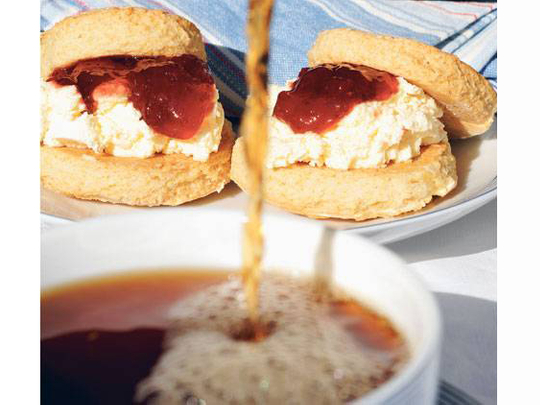
Few things encapsulate a British summer more than a traditional cream tea. If you want the true taste of summer, making and serving cream tea is a doddle. Lee Groves, the head chef at Cornwall's Headland Hotel, explains how.
Ingredients
To make 16 scones, you will need four ounces of self-raising flour, a pinch of baking powder, an ounce of unsalted butter, an ounce of caster sugar and seven ounces of liquid.
If you want a light scone, use water. For a richer scone, use full-fat milk. If you want fruit scones, add two ounces of dry fruits — raisins, sultanas, currants, apricots or dried banana. And, of course, you'll need strawberry jam and clotted cream to serve with them.
Equipment
You can guesstimate on the fruit — which is purely a matter of taste. But it's vital to get all the other quantities right. So you will need kitchen scales. You'll also need a large mixing bowl, a wooden spoon, a rolling pin, a two-inch pastry- or scone-cutter and an ovenproof tray.
Method
Put all the ingredients, apart from the liquid, into a mixing bowl. Using both hands, rub the mixture through your fingers until it resembles fine breadcrumbs. This takes about six minutes.
Pour in the liquid and beat with a wooden spoon until you have a dough-like consistency.
The secret is to mix as rapidly as you can with minimum handling. If you handle too much, you risk overdeveloping the gluten, which will make the scones tough. You're done when you have a lump-free, dough-like mixture. This takes four minutes.
Keep it chilled
Sprinkle your work surface with flour. A marble slab is ideal, as it's important to keep the dough as cold as possible, otherwise the butter starts leaking out, making the scones taste fatty.
Dust the dough with a light sprinkling of flour. Once again, the less you handle the mixture, the better. Use a rolling pin to gently roll the mixture out until it is around an inch in thickness. Don't be tempted to push with your hands, as you risk making the mixture heavy.
Ready to bake
Lightly grease your ovenproof tray with butter and then dust lightly with flour so the scones won't stick. Take the pastry-cutters and start shaping the scones. After cutting each scone, dip the cutter in flour. This will stop the mixture from sticking to the cutter and ensure an even shape.
Place all the scones on the tray and set aside for 15 minutes. Resting ensures they cook evenly. Put the tray in the oven at 180C/gas mark 5 for 16 minutes.
Check whether the scones are ready by squeezing lightly between your thumb and forefinger. There should be no resistance. Don't touch the top, as you might crack the scone. Cool at room temperature for 30 minutes.
Serving etiquette
Remove the clotted cream from the fridge, spoon into a small serving bowl and leave at room temperature for 30 minutes. Decant the strawberry jam into a large bowl — or individual bowls for each guest if you prefer.
Place the scones on a platter. Each guest should have a small side plate, a knife and teaspoon.
For traditionalists, there's only one way to eat cream tea and that's jam first, followed by cream.
Even the etiquette experts at Debrett's agree: You cut the scone in half, spread the jam on first and top with cream. Serve with a pot of freshly brewed tea.
The full experience
For a fuller afternoon tea, try serving cupcakes. Savouries are also welcome: Welsh rarebit, finger sandwiches — never triangles — with cucumber, smoked salmon, egg mayonnaise and cress.
A bowl of strawberries also goes well with clotted cream.












